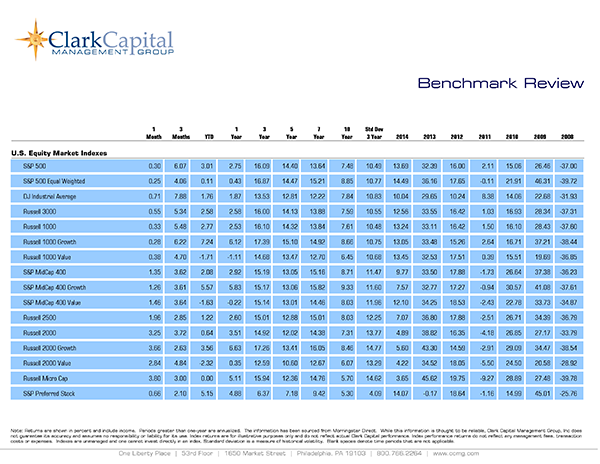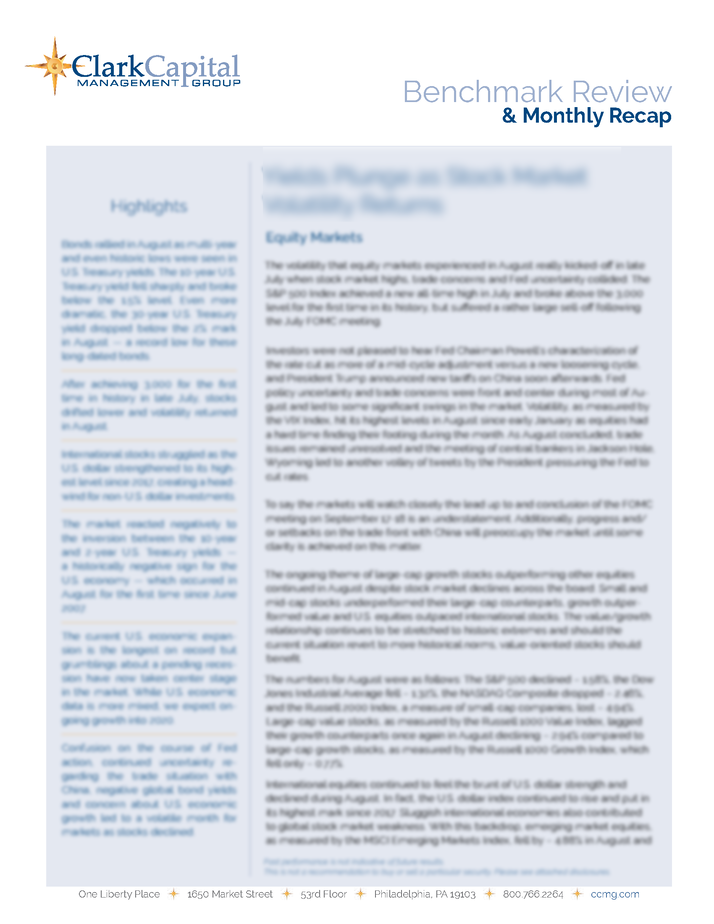2023 Ends Strongly as Rally Continued in December
HIGHLIGHTS:
- The last two months of 2023 drove returns in many parts of the market for the entire year. The stock market rally broadened in December and underperforming areas like small-cap stocks rose sharply to turn in solid annual gains. Large-cap growth still dominated the year, but 2023 turned out to be a strong year overall for stocks.
- Yields continued to fall in December. The yield on the 10-year U.S. Treasury closed November at 4.37% and dropped to end the year at 3.88%. This drop in rates from the October highs and subsequent rally in bond prices resulted in solid bond returns for 2023 – again, driven primarily by late-year gains.
- Much of the rally in stocks and bonds can be attributed to the market’s strengthening belief that this rate-hike cycle is finished. The first FOMC meeting of 2024 occurs at the end of January and the fed fund futures are pricing in a first right hike occurring in March. We’ll see.
- The U.S. economy continues to grow, but Q4 growth will likely pale in comparison to the torrid pace of growth from Q3. While odds have likely increased for a “soft landing,” there is still a possibility of a mild recession, and that potential outcome should not be ignored.
- Finally, corporate earnings are improving and expected to grow in calendar years 2023 and 2024. While expected earnings growth has moderated somewhat for 2023, earning expectations for 2024 have remained solid.
EQUITY MARKETS
After three straight months of declines through October, stocks rallied in November and December. The rally in December was across the board, but some of the lagging parts of the market rebounded sharply in the last month of the year. Small-caps enjoyed a double-digit monthly gain, which drove most of their 2023 results.
With the market gaining confidence that this Fed rate hike cycle might be over, stocks gained momentum in December and rates dropped dramatically leading to a solid month of returns in both stocks and bonds. See Table 1 for equity results for December, Q4, and 2023.
Table 1
| Index | December 2023 | Q4 | 2023 |
|---|---|---|---|
| S&P 500 | 4.54% | 11.69% | 26.29% |
| S&P 500 Equal Weight | 6.86% | 11.87% | 13.87% |
| DJIA | 4.93% | 13.09% | 16.18% |
| Russell 3000 | 5.30% | 12.07% | 25.96% |
| NASDAQ Comp. | 5.58% | 13.79% | 44.64% |
| Russell 2000 | 12.22% | 14.03% | 16.93% |
| MSCI ACWI ex U.S. | 5.02% | 9.75% | 15.62% |
| MSCI Emerging Mkts Net | 3.91% | 7.86% | 9.83% |
In our opinion 2023 will be remembered for the dominance of large-cap growth. However, the broadening in the market over the last two months of the year led to solid gains across the board in equity markets. The S&P 500 Equal Weight Index, the Russell 2000 Index, and the MSCI Emerging Markets Index show the bulk of their gains came late in the year as most parts of the market outside of large-cap growth were lackluster for much of 2023. The indices driven by large-cap growth companies including the S&P 500 Index, the NASDAQ Composite, and the Russell 3000 showed strong gains in the fourth quarter as well, which added to what was already a strong year of results. The Russell 2000 Index led the broader markets higher in December and those gains drove the overall 2023 results for small-caps.
Broad international equities showed solid returns in December as well. The MSCI ACWI ex. U.S. Index showed returns more or less in line with many parts of the U.S. markets (outside of large-cap growth companies). Emerging markets proved to be the weak spot in 2023, but even with that said, the MSCI Emerging Market Index was up just shy of 10% for 2023. We still see opportunities in international markets with valuations that are lower than the U.S. and our expectation that the U.S. dollar will largely weaken over the short-to-intermediate term. Coinciding with the market gaining confidence around the conclusion of this rate hike cycle, the dollar weakened in November and December and appears to be trending lower.
Fixed Income
After struggling for much of the year, bonds rallied in November and December to turn in solid results for 2023. The grind higher in rates through the summer and into the fall had dragged bond returns down with most major bond indices ending in negative territory year-to-date through October. However, November saw bond yields drop sharply, and bonds staged a significant rally during the month and that momentum continued in December. It is a good reminder that yields can move quickly at times, and it is important for bond investors to stay focused on their long-term goals during periods of volatility. We know the vast majority of a bond’s return is interest income and the reinvestment of that income, but when rates are moving, bond prices can fluctuate in the short term.
The 10-year U.S. Treasury yield dropped in November from 4.88% (October’s close) to 4.37% by the end of November. This move continued lower, and the yield ended 2023 at 3.88%. That decline in rates became a tailwind for bond returns late in the year. An interesting side note, the 10-year U.S. Treasury closed 2022 at that exact yield level of 3.88% as well, but we all know there was a lot of volatility between those two points in time throughout 2023. See Table 2 for fixed income index returns for December, Q4, and year to date.
Table 2
| Index | December 2023 | Q4 | 2023 |
|---|---|---|---|
| Bloomberg U.S. Agg | 3.83% | 6.82% | 5.53% |
| Bloomberg U.S. Credit | 4.19% | 8.15% | 8.18% |
| Bloomberg U.S. High Yld | 3.73% | 7.16% | 13.44% |
| Bloomberg Muni | 2.32% | 7.89% | 6.40% |
| Bloomberg 30-year U.S. TSY | 8.71% | 12.85% | 1.93% |
| Bloomberg U.S. TSY | 3.36% | 5.66% | 4.05% |
The move higher in rates during much of 2023 presented bond investors with opportunities to invest at higher yields and coupons than seen in several years. We expect the 10-year U.S. Treasury yield to move lower as we move into 2024, but we also anticipate volatility along the way. We maintain our long-standing position favoring credit versus pure rate exposure in this interest rate environment. We also believe the role bonds play in a portfolio, to provide stable cash flow and to help offset the volatility of stocks in the long run, has not changed. Furthermore, we believe that bond yields remain attractive even though rates have dropped rather sharply over the last two months. In our opinion, having an active approach in fixed income can help navigate these volatile times.
Economic Data and Outlook
The final look at Q3 2023 economic growth showed a revision back to its original estimate of 4.9%. This was a drop from the expected final update and prior reading of 5.2%, but still shows a solid quarter of growth. Fourth quarter GDP will likely slow from this level, and we will get this initial reading in late January. We do expect growth to slow from the strong Q3 pace and believe the rate hikes are still working their way through the economy and will likely result in a period of slower economic growth in 2024.
Job market progress continued in November and payroll additions improved from October and were better than expected. Non-farm payroll additions were 199,000 in November, which was more than the 185,000 expected and improved from the 150,000 in October. The unemployment rate unexpectedly ticked lower to 3.7% when it was expected to stay at the prior month’s level of 3.9%.
Average hourly earnings grew by 4.0% on an annual basis, which matched expectations and the prior month’s level. Job openings fell rather sharply in October to 8.733 million. Expectations were calling for 9.3 million openings and this compared to the revised 9.35 million openings from September. Job openings remain plentiful, but they are down from their peak levels. The aggressive rate hikes by the Fed might be having an impact on hiring decisions as job openings have trended lower. However, the labor market remains solid with millions more jobs available compared to unemployed people. Chart 1 shows this relationship between job openings and the unemployment level, and we can see that this gap has been narrowing of late.
Chart 1
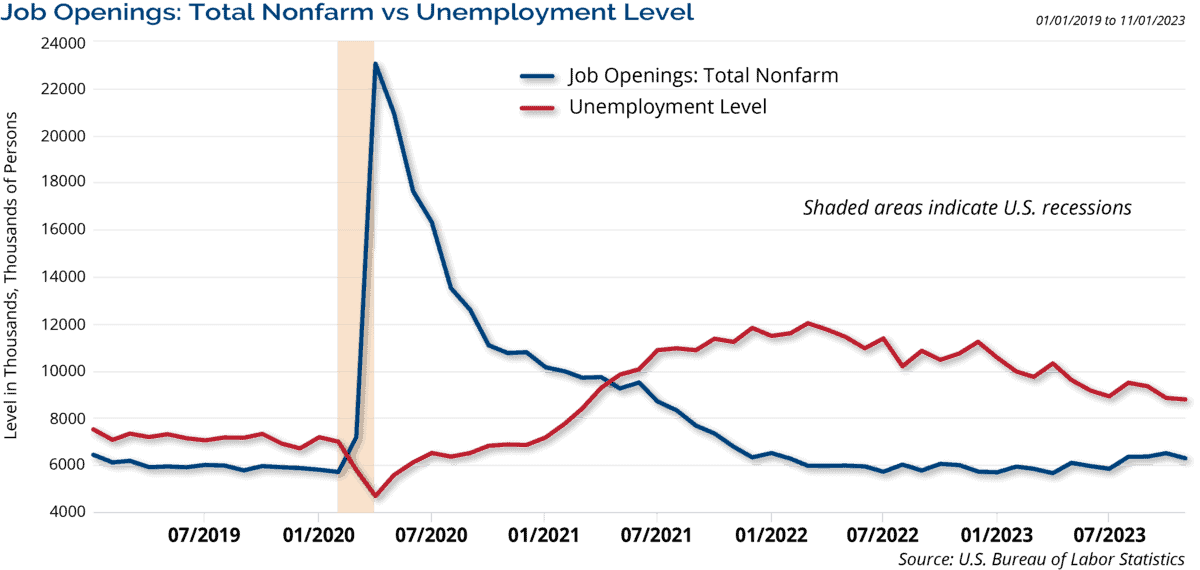
For illustrative purposes only.
With the current strength in the job market, we maintain our opinion that it seems unlikely that the economy would slow too drastically under these conditions. However, even a modest slowdown in the job market could be a headwind to economic activity due to the central role that consumer spending plays in the U.S. economy. The odds of a soft landing have likely increased in recent months, but a reasonable probability of a mild recession still exists and should not be dismissed. We believe opportunities exist in the stock and bond markets under either of these two scenarios as consumers remain strong and the job market remains healthy.
Positive inflation data seemed to be one of the primary catalysts that pushed stocks and bonds higher to close out the year. The headline Consumer Price Index (CPI) showed an annual increase of 3.1% in November, which was in-line with expectations and a modest improvement from the prior month’s reading of 3.2%. The core CPI increased by 4.0% in November as expected and matched October’s reading. The headline Producer Price Index (PPI) was flat as expected in November. This made the annual gain 0.9%, which was better than the expected 1.0% increase. The core PPI had an annual increase of 2.0% in November, which was better than expectations of 2.2% and the prior month’s mark of 2.3%. These improvements on the inflation front seemed to bolster the market’s belief that the Fed might be done with this rate hike cycle. After over a year and a half of “fighting the Fed”, the market reacted positively to data that supported the idea that this fight might be over.
Focusing on the preferred inflation measure of the Federal Reserve, the Personal Consumption Expenditures (PCE) Index showed a 2.6% annual gain in November, which was better than expectations of 2.8% and the prior month’s level of 2.9%. The core PCE reading (the reading the Fed targets) was 3.2%, surpassing expectations of 3.3% and improving from the prior month’s level of 3.4%. The Fed’s preferred measure of inflation, the core PCE Price Index has improved, but it remains elevated from the Fed’s long-term target of around 2%. Chart 2 shows improvements in core consumer inflation readings – the core CPI Price Index and the core PCE Price Index, but prices are still above their pre-pandemic levels and the Fed’s target.
Chart 2
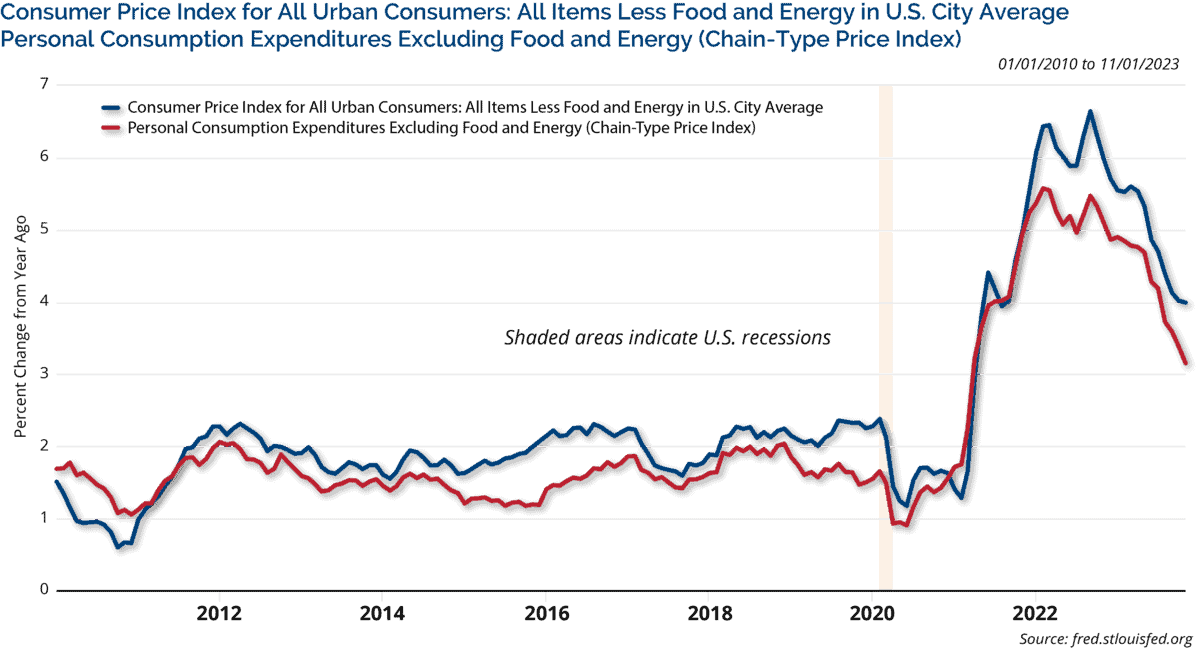
Progress has been made on inflation, but Fed Chairman Powell continues to reiterate that the inflation battle is not over. However, enough progress seems to have been made that the Fed has likely concluded this rate hike cycle. The market is pricing in no more rate hikes and the Fed Futures are anticipating a potential first rate cut in March. We believe this might be the market getting ahead of itself, but we do believe the rate hike cycle is over and the next move by the Fed will eventually be a cut.
Mortgage rates remain elevated, but they have improved as interest rates in general have declined in recent months. In November, building permits, considered a leading indicator for housing, fell from October and were below expectations. However, housing starts surged and surpassed the prior month’s level and expectations. Existing home sales were modestly improved from October and just slightly ahead of expectations. New home sales fell rather sharply and missed expectations by 100,000 for the month. Home prices continued their recent rise and gained 4.87% in October. While modestly behind estimates of a 4.99% increase, the gain did surpass September’s annual increase of 3.92% based on the S&P CoreLogic 20-City Index. As previously mentioned, mortgage rates shot higher in October and stood at multi-year highs. However, interest rates and mortgage rates did drop rather sharply in November and that continued in December. It will be important to see how housing reacts in the months ahead as mortgage rates have moderated. Chart 3 shows the relationship between mortgage rates and building permits.
Chart 3
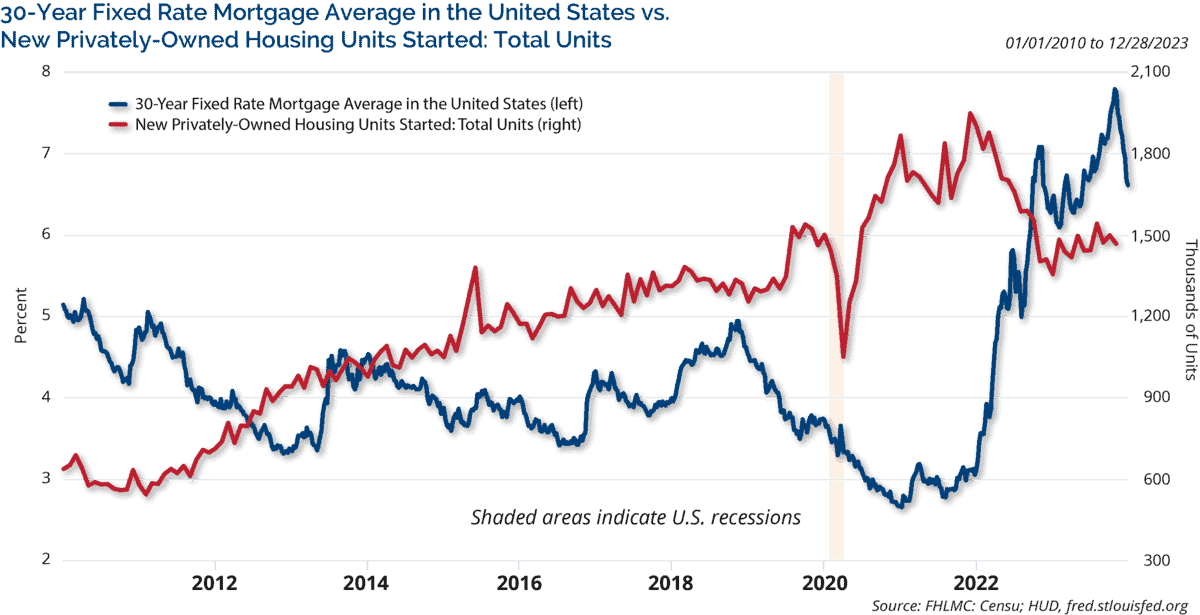
The ISM Manufacturing Index for November was disappointing and marked the 13th straight month of contraction for this index. At 46.7, the index was lower than expectations of 47.8 and matched October’s mark. The ISM Non-Manufacturing Index, which covers the much larger service industries in the U.S. economy, came in at 52.7 in November, an improvement from October’s 51.8 reading, and ahead of estimates of 52.3. The service industries still reflected growth in November, which helped lift the overall economy. Recall, the dividing line between expansion and contraction for the ISM indices is 50.
The health of U.S. consumers is being highly scrutinized due to their significant role in the U.S. economy. Retail sales (ex. auto and gas) rose by 0.6% in November, a much stronger gain than the expected 0.2% increase. The preliminary University of Michigan Sentiment reading for December surged to 69.4 compared to expectations of 62.0 and the previous 61.3 level, which is not too surprising considering the recent strength seen in the stock market. The Conference Board’s Leading Index continued to decline and fell by -0.5% in November as expected. Furthermore, the prior month was revised to show a -1.0% decline compared to the prior estimate of a -0.8% drop. For well over a year, the leading economic index has been flashing a warning sign of pending economic weakness which has yet to materialize to any large degree, but we still pay attention to this index.
As always, we believe it is imperative for investors to stay focused on their long-term goals and not let short-term swings in the market derail them from their longer-term objectives.
Investment Implications
Clark Capital’s Top-Down, Quantitative Strategies
The markets enter the year overbought with overly optimistic investor sentiment. Our credit-based risk management models remain firmly risk-on, and therefore we would expect any weakness as we turn the calendar to be short lived.
Clark Capital’s Bottom-Up, Fundamental Strategies
After a long period of underperformance coinciding with Fed tightening and Lead Economic Indicator (LEI) declines, small-cap U.S. equities staged a powerful move in both November and December. December’s 12.2% gain for the Russell 2000 Small Cap Index brought the quarterly gain to 14%, nearly matching the advance of the Russell 1000 Large Cap Index. From the October market low, the three major indices closed 2023 posting a nine-week winning streak, which ignited a leadership rotation.
ECONOMIC DATA
| Event | Period | Estimate | Actual | Prior | Revised |
|---|---|---|---|---|---|
| ISM Manufacturing | Nov | 47.8 | 46.7 | 46.7 | — |
| ISM Services Index | Nov | 52.3 | 52.7 | 51.8 | — |
| Change in Nonfarm Payrolls | Nov | 185k | 199k | 150k | — |
| Unemployment Rate | Nov | 3.90% | 3.70% | 3.90% | — |
| Average Hourly Earnings YoY | Nov | 4.00% | 4.00% | 4.10% | 4.00% |
| JOLTS Job Openings | Oct | 9300k | 8733k | 9553k | 9350k |
| PPI Final Demand MoM | Nov | 0.00% | 0.00% | -0.50% | -0.40% |
| PPI Final Demand YoY | Nov | 1.00% | 0.90% | 1.30% | 1.20% |
| PPI Ex Food and Energy MoM | Nov | 0.20% | 0.00% | 0.00% | — |
| PPI Ex Food and Energy YoY | Nov | 2.20% | 2.00% | 2.40% | 2.30% |
| CPI MoM | Nov | 0.00% | 0.10% | 0.00% | — |
| CPI YoY | Nov | 3.10% | 3.10% | 3.20% | — |
| CPI Ex Food and Energy MoM | Nov | 0.30% | 0.30% | 0.20% | — |
| CPI Ex Food and Energy YoY | Nov | 4.00% | 4.00% | 4.00% | — |
| Retail Sales Ex Auto and Gas | Nov | 0.20% | 0.60% | 0.10% | — |
| Industrial Production MoM | Nov | 0.30% | 0.20% | -0.60% | -0.90% |
| Building Permits | Nov | 1465k | 1460k | 1487k | 1498k |
| Housing Starts | Nov | 1360k | 1560k | 1372k | 1359k |
| New Home Sales | Nov | 690k | 590k | 679k | 672k |
| Existing Home Sales | Nov | 3.78m | 3.82m | 3.79m | — |
| Leading Index | Nov | -0.50% | -0.50% | -0.80% | -1.00% |
| Durable Goods Orders | Nov P | 2.30% | 5.40% | -5.40% | -5.10% |
| GDP Annualized QoQ | 3Q T | 5.20% | 4.90% | 5.20% | — |
| U. of Mich. Sentiment | Dec P | 62.0 | 69.4 | 61.3 | — |
| Personal Income | Nov | 0.40% | 0.40% | 0.20% | 0.30% |
| Personal Spending | Nov | 0.30% | 0.20% | 0.20% | 0.10% |
| S&P CoreLogic CS 20-City YoY NSA | Oct | 4.99% | 4.87% | 3.92% | — |
Source: Bloomberg
Past performance is not indicative of future results. The opinions referenced are as of the date of publication and are subject to change due to changes in the market or economic conditions and may not necessarily come to pass. Material presented has been derived from sources considered to be reliable and has not been independently verified by us or our personnel. Nothing herein should be construed as a solicitation, recommendation or an offer to buy, sell or hold any securities, other investments or to adopt any investment strategy or strategies. Investors must make their own decisions based on their specific investment objectives and financial circumstances. Investing involves risk, including loss of principal.
Clark Capital Management Group is an investment adviser registered with the U.S. Securities and Exchange Commission. Registration does not imply a certain level of skill or training. More information about Clark Capital Management Group’s advisory services can be found in its Form ADV which is available upon request.
Fixed income securities are subject to certain risks including, but not limited to: interest rate (changes in interest rates may cause a decline in market value or an investment), credit, prepayment, call (some bonds allow the issuer to call a bond for redemption before it matures), and extension (principal repayments may not occur as quickly as anticipated, causing the expected maturity of a security to increase).
Clark Capital utilizes a proprietary investment model to assist with the construction of the strategy and to assist with making investment decisions. Investments selected using this process may perform differently than expected as a result of the factors used in the model, the weight placed on each factor, and changes from the factors’ historical trends. There is no guarantee that Clark Capital’s use of a model will result in effective investment decisions.
Non-investment-grade debt securities (high-yield/junk bonds) may be subject to greater market fluctuations, risk of default or loss of income and principal than higher-rated securities.
Foreign securities are more volatile, harder to price and less liquid than U.S. securities. They are subject to different accounting and regulatory standards and political and economic risks. These risks are enhanced in emerging market countries.
The value of investments, and the income from them, can go down as well as up and you may get back less than the amount invested.
Equity securities are subject to price fluctuation and possible loss of principal. Stock markets tend to move in cycles, with periods of rising prices and periods of falling prices. Certain investment strategies tend to increase the total risk of an investment (relative to the broader market). Strategies that concentrate their investments in limited sectors are more vulnerable to adverse market, economic, regulatory, political, or other developments affecting those sectors.
JOLTS is a monthly report by the Bureau of Labor Statistics (BLS) of the U.S. Department of Labor counting job vacancies and separations, including the number of workers voluntarily quitting employment.
The Producer Price Index (PPI) program measures the average change over time in the selling prices received by domestic producers for their output. The prices included in the PPI are from the first commercial transaction for many products and some services.
References to market or composite indices, benchmarks or other measures of relative market performance over a specified period of time (each, an “index”) are provided for your information only. Reference to an index does not imply that the portfolio will achieve returns, volatility or other results similar to that index. The composition of the index may not reflect the manner in which a portfolio is constructed in relation to expected or achieved returns, portfolio guidelines, restrictions, sectors, correlations, concentrations, volatility or tracking error targets, all of which are subject to change. Investors cannot invest directly in an index.
The Bloomberg Barclays U.S. Municipal Index covers the USD-denominated long-term tax exempt bond market. The index has four main sectors: state and local general obligation bonds, revenue bonds, insured bonds and prerefunded bonds.
The Bloomberg US Treasury Index measures US dollar-denominated, fixed-rate, nominal debt issued by the US Treasury. Treasury bills are excluded by the maturity constraint, but are part of a separate Short Treasury Index.
The Dow Jones Industrial Average indicates the value of 30 large, publicly owned companies based in the United States.
The NASDAQ Composite is a stock market index of the common stocks and similar securities listed on the NASDAQ stock market.
The S&P 500 measures the performance of the 500 leading companies in leading industries of the U.S. economy, capturing 80% of U.S. equities.
The S&P 500® Equal Weight Index (EWI) is the equal-weight version of the widely-used S&P 500. The index includes the same constituents as the capitalization weighted S&P 500, but each company in the S&P 500 EWI is allocated a fixed weight – or 0.2% of the index total at each quarterly rebalance.
The University of Michigan Consumer Sentiment Index rates the relative level of current and future economic conditions. There are two versions of this data released two weeks apart, preliminary and revised. The preliminary data tends to have a greater impact. The reading is compiled from a survey of around 500 consumers.
The Russell 1000 Growth Index measures the performance of the large-cap growth segment of the U.S. equity universe. It includes those Russell 1000 Index companies with higher price-to-book ratios and higher forecasted growth values.
The Russell 1000 Value Index measures the performance of the large-cap value segment of the U.S. equity universe. It includes those Russell 1000 Index companies with lower price-to-book ratios and lower forecasted growth values.
The Russell 2000 Index is a small-cap stock market index that represents the bottom 2,000 stocks in the Russell 3000.
The Russell 3000 Index measures the performance of the 3,000 largest U.S. companies based on total market capitalization, which represents approximately 98% of the investable U.S. equity market.
The 10 Year Treasury Rate is the yield received for investing in a US government issued treasury security that has a maturity of 10 year. The 10 year treasury yield is included on the longer end of the yield curve. Many analysts will use the 10 year yield as the “risk free” rate when valuing the markets or an individual security.
The Bloomberg Barclays U.S. Corporate High-Yield Index covers the U.S. dollar-denominated, non-investment grade, fixed-rate, taxable corporate bond market. Securities are classified as high-yield if the middle rating of Moody’s, Fitch, and S&P is Ba1/BB+/BB+ or below.
The Bloomberg Barclays U.S. Credit Index measures the investment grade, U.S. dollar denominated, fixed-rate taxable corporate and government related bond markets.
The Bloomberg Aggregate Bond Index or “the Agg” is a broad-based fixed-income index used by bond traders and the managers of mutual funds and exchange-traded funds (ETFs) as a benchmark to measure their relative performance.
The 30-Year Treasury is a U.S. Treasury debt obligation that has a maturity of 30 years. The 30-year Treasury used to be the bellwether U.S. bond but now most consider the 10-year Treasury to be the benchmark.
The ISM Non-Manufacturing Index is an index based on surveys of more than 400 non-manufacturing firms’ purchasing and supply executives, within 60 sectors across the nation, by the Institute of Supply Management (ISM). The ISM Non-Manufacturing Index tracks economic data, like the ISM Non-Manufacturing Business Activity Index. A composite diffusion index is created based on the data from these surveys, that monitors economic conditions of the nation.
ISM Manufacturing Index measures manufacturing activity based on a monthly survey, conducted by Institute for Supply Management (ISM), of purchasing managers at more than 300 manufacturing firms.
The MSCI Emerging Markets Index captures large and mid cap representation across 27 Emerging Markets (EM) countries.
The MSCI ACWI ex USA Index captures large and mid cap representation across 22 of 23 Developed Markets (DM) countries (excluding the US) and 27 Emerging Markets (EM) countries*. With 2,359 constituents, the index covers approximately 85% of the global equity opportunity set outside the US
The S&P CoreLogic Case-Shiller 20-City Composite Home Price NSA Index seeks to measures the value of residential real estate in 20 major U.S. metropolitan areas. The U.S. Treasury index is based on the recent auctions of U.S. Treasury bills. Occasionally it is based on the U.S. Treasury’s daily yield curve.
The Consumer Price Index (CPI) measures the change in prices paid by consumers for goods and services. The CPI reflects spending patterns for each of two population groups: all urban consumers and urban wage earners and clerical workers.
In the United States, the Core Personal Consumption Expenditure Price (CPE) Index provides a measure of the prices paid by people for domestic purchases of goods and services, excluding the prices of food and energy.
The VIX Index is a calculation designed to produce a measure of constant, 30-day expected volatility of the U.S. stock market, derived from real-time, mid-quote prices of S&P 500® Index (SPX℠) call and put options. On a global basis, it is one of the most recognized measures of volatility — widely reported by financial media and closely followed by a variety of market participants as a daily market indicator.
The Conference Board’s Leading Indexes are the key elements in an analytic system designed to signal peaks and troughs in the business cycle. The leading, coincident, and lagging economic indexes are essentially composite averages of several individual leading, coincident, or lagging indicators. They are constructed to summarize and reveal common turning point patterns in economic data in a clearer and more convincing manner than any individual component – primarily because they smooth out some of the volatility of individual components.
Gross domestic product (GDP) is the standard measure of the value added created through the production of goods and services in a country during a certain period.
Index returns include the reinvestment of income and dividends. The returns for these unmanaged indexes do not include any transaction costs, management fees or other costs. It is not possible to make an investment directly in any index.
CCM-993
